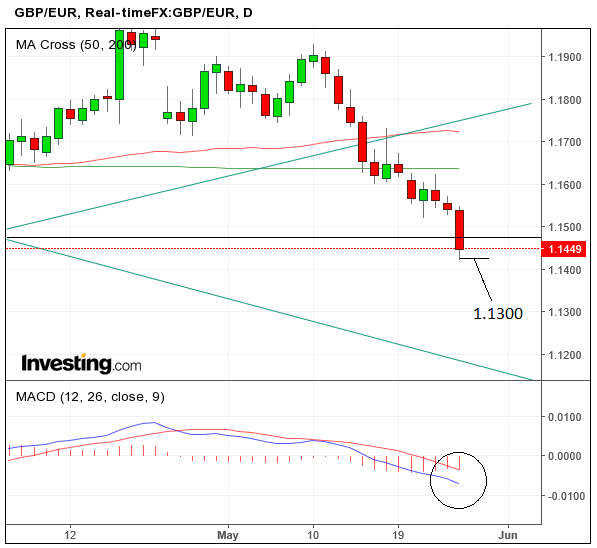5-Day GBP/EUR Rate Forecast: Technicals, Politics and Data to Watch

The British Pound is seen moving higher against the Euro at the start of a new week in line with our expectations published over the weekend.
We noted Sterling to be oversold on a technical basis and also believed that polling data would confirm Theresa May's Conservatives had seen their drop in support end.
Taking the average of all the new polls released over the weekend, the Conservatives are 10pts ahead.
According to the Electoral Calculus model, this would translate into a majority of 81 seats.
At the time of writing one Pound buys 1.1481 Euros, up from an opening amount of 1.1457.
Concerning the outlook for the remainder of the week we believe the GBP/EUR exchange rate is however vulnerable to further losses as the strong 'down day' seen last Friday was a clear signal of bearish intent.
"Markets still appear to be priced for a larger majority than this, with bookmakers’ prices putting the majority at 109, thought his has also fallen sharply from 161 less than a month ago. While this implied majority is still trending lower, we retain a negative bias on GBP," says Adam Cole, an analyst with RBC Capital Markets in London.
Currencies have a habit of trending and are more likely to ‘extend’ than ‘bend’, so the overall technical picture still supports more downside, in my opinion.
The MACD momentum indicator in the lower pane has passed below the zero-line which is a sign we are now in a downtrend. Due to its trajectory, it also looks more likely to fall than rise.

We see a break below Friday’s lows at 1.1424 as providing fresh confirmation of more downside and likely to lead to move down to 1.1300.
There is no real technical support until you reach the trendline at 1.1175 so the pair could fall as low as that, but we see a lack of obvious triggers over the next week as making such a major re-evaluation unlikely.
From a fundamental perspective, of importance for Sterling are the ongoing poll results for the up-and-coming June elections.
The Pound weakened last week after Theresa May’s lead was cut to only 5% from 19%, as the possibility of her having a powerful majority declined.
We can report that the latest set of polls for the national Sunday papers confirm the shift towards Labour hinted at by Thursday's YouGov poll that sent Sterling on a tumble.
However, another YouGov poll for the Sunday Times shows the Conservative's have recovered some of that loss of ground reported in their poll from last week.
Recall the YouGov poll for the Times that showed Labour had narrowed the gap to 5% while the latest poll shows Labour have shed 2% to 36%, the Conservatives are unchanged at 43%.
Opinium report that May's lead had slipped to 10%, down from a 13% the week before and from 19% on April 19.
ComRes reports that the Conservative's lead had fallen to 12%, from 18% in a comparable poll on May 13.
ORB say May's lead had halved to 6%.
It is reported that the Conservative's election strategist Lynton Crosby has order the party to return to its main message: That only Theresa May can be trusted to negotiate Brexit.
What to Watch: Data for the Pound
It is a quiet week for UK data with the main event Manufacturing PMI for May, out at 9.30 BST on Thursday, and Construction PMI, out at 9.30 on Friday.
Manufacturing activity is expected to fall to 56.5 from 57.3 – only a deeper decline, however, would be market moving.
Last month Manufacturing PMI reached a 3-year high on the back of a surge in New Orders so the overall view supports a shallower decline if anything.
“We look for PMI to hold onto most of last month’s gains with just a small pull-back 57.0,” said Canadian investment bank TD Securities.
A similar marginal decline to 52.7 from 53.1 is foreseen in construction activity in May, out on Friday, June 2.
House Prices are also out at 7.00 on Thursday.
What to Watch: Data for the Euro
The main event for the Euro will be inflation data out on Wednesday, May 31 at 10.00 BST.
Inflation impacts on the policy decisions of the European Central Bank (ECB) which means that if it goes up substantially the central bank is more likely to raise interest rates (or normalise policy).
Higher interest rates strengthen a currency as they attract more flows of international capital.
The expectation for the data out on Wednesday is that inflation will fall to 1.5% from 1.9% year-on-year in May, but that this is more to do with an “Easter effect” than a real decline in underlying inflation.
“We look to Eurozone inflation to slip back to 1.5% y/y in May as the Easter effect falls out of the equation. This is below the ~1.75% rate that the ECB had forecast in March. And with core CPI falling back down to 1.0% y/y, we don’t think that the Eurozone is anywhere near a place yet where the ECB can declare a convincing upward trend in underlying inflation,” said Toronto-based TD Securities.
The other major release for the Euro in the week ahead is the Unemployment Rate out at 10.00 on Wednesday and is forecast to fall to 9.4% in April from 9.5% previously.
The release will be important given all the talk about the Eurozone economic recovery, and another fall in the Unemployment Rate will probably bolster this view.
“The near-term political risks have faded and the latest economic reports were positive for the euro – German investor confidence rose strongly in May, the Eurozone’s trade surplus hit a 3-month high and there was no revision to the Eurozone’s Q1 GDP and French CPI reports. Even ECB President Draghi acknowledged the euro-area recovery as resilient and increasingly broad-based,” said BK Asset Management’s Kathy Lien.





